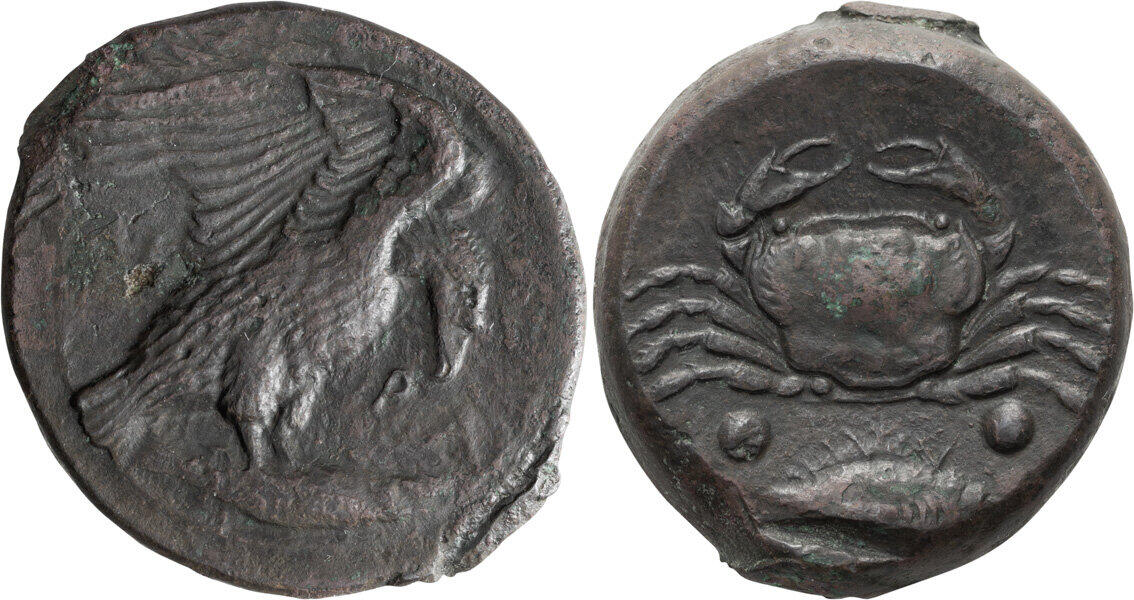S 1508 - Agrigentum, bronze, hexantes (415-406 BCE)
From SILVER
415 BCE - 406 BCE Bronze
Description
| ObverseInscription or printing placed on the obverse.: | AK - PA across field (Greek).Eagle with spread wings standing r. on fish |
| ReverseInscription or printing placed on the reverse.: | Crab, two pellets and fish below |
Mint and issuing power
| MintIdentifies the place of manufacture or issue of a numismatic object.: | Agrigentum | Ancient regionAncient region.: | Sicily | Modern countryModern country: Italy | AuthorityIdentifies the issuing power. The authority can be "pretended" when the name or the portrait of X is on the coin but he/she was not the issuing power. It can also be "uncertain" when there is no mention of X on the coin but he/she was the issuing power according to the historical sources: |
Chronology
| FromIdentifies the initial date in a range assigned in a numismatic context. | 415 BCE | toIdentifies the final date in a range assigned in a numismatic context.. | 406 BCE | PeriodTime period of the numismatic object.: Classical 480-323 BC |
Physical description
| MetalThe physical material (usually metal) from which an object is made.: | Bronze |
Median weightMedian of the weights of numismatic objects (in grams). in grams | 7.10 | DenominationTerm indicating the value of a numismatic object. Examples: tetradrachm, chalkous, denarius.: | hexas |
StandardStandard.: |
Image

S 1508 - Agrigentum, bronze, hexantes (415-406 BCE).jpg [1]
References
| Die study referencePublication of the study: | Westermark 20181Westermark 2018, p. 266-282, n° 918-989 | ||
| Coin series referenceReference to coin series study: | |||
Obverse dies distribution
| FrequencyFrequency of specimen in distribution. ᵖ | Number of obversesNumber of obverse dies. ᵖ (o) | % (o) | Number of coinsNumber of coins. (n) | % (n) | Die nameName(s) of the die(s). |
| 1 | 4 | 8.51 | 4 | 1.26 | H2;F3;F24;F26 |
| 2 | 6 | 12.77 | 12 | 3.79 | B4;F7;F9;F20;F21;F22 |
| 3 | 7 | 14.89 | 21 | 6.62 | H3;P2;F5;F6;F14;F27;F30 |
| 4 | 5 | 10.64 | 20 | 6.31 | H5;F8;F19;F25;F29 |
| 5 | 2 | 4.26 | 10 | 3.15 | B6;F18 |
| 6 | 4 | 8.51 | 24 | 7.57 | H4;P4;F4;F17 |
| 7 | 2 | 4.26 | 14 | 4.42 | F11;F12 |
| 8 | 3 | 6.38 | 24 | 7.57 | B7;F2;F10 |
| 9 | 4 | 8.51 | 36 | 11.36 | B3;F1;F13;F23 |
| 10 | 1 | 2.13 | 10 | 3.15 | F28 |
| 11 | 3 | 6.38 | 33 | 10.41 | H1;B2;P1 |
| 13 | 1 | 2.13 | 13 | 4.1 | F15 |
| 15 | 1 | 2.13 | 15 | 4.73 | B5 |
| 16 | 1 | 2.13 | 16 | 5.05 | F16 |
| 18 | 1 | 2.13 | 18 | 5.68 | B1 |
| 20 | 1 | 2.13 | 20 | 6.31 | P3 |
| 27 | 1 | 2.13 | 27 | 8.52 | S1 |
| Total | 47 of 47 | 100.02 | 317 of 317 | 100 |
Reverse dies distribution
no distribution is available
Quantification
| Number of obversesNumber of obverse dies. ᵖ (o) | 47 | Number of singletons (o1)The number of singleton coins. ᵖ | 4 |
| Number of reverse diesNumber of reverse dies. (r) | 59 | Number of coinsNumber of coins. (n) | 317 |
| Coins per obverse dieNumber of coins per obverse die. (n/o) | 6.74 | Coins per reverse dieNumber of coins per reverse die. (n/r) | 5.37 |
| Reverse per obverse ratioRatio of obverse dies divided by reverse dies. (r/o) | 1.26 | Percentage of singletons (o1)number of coins (n) divided by the number of singletons (o1) ᵖ | 8.51 % |
| Original number of dies (O) (Carter 1983 formula)The estimation of the number of coins according to Carter 1983 ᵖ | 49.79 | Coins struck if 20,000 as average productivity per dieCoins made if the average productivity for obverses (according to Carter) is 20,000. ᵖ | 995,800 |
| Original number of dies (O) (Esty 2011 formula)The estimation of the number of coins according to the singleton formula in Esty 2011 ᵖ (O) | 55.18 | Survival rate if 20,000 as average productivity per dieSurvival rate if average productivity is 20,000. ᵖ | 0.00032 |
| Coverage (o = % of O) (Esty 1984 formula)Esty 1984 - coverage (% of O) ᵖ (o = % of O) | 98.74% | Die productivity if survival rate 1/2,000Average productivity if survival rate is 1/2,000. ᵖ | 12,733.48 |
| Weight of silver (in kg) if 20,000 coins per die (O = Carter formula)Carter 1983 * Median weight * 20000 (*10 if gold or electrum) ᵖ | n.a. | Die productivity if survival rate 1/5,000Average productivity if survival rate is 1/5,000. ᵖ | 31,833.7 |
Remarks
The letters refer to the types of the reverse dies: H for Hare, B for Bird, P for Pig, F for Fisch, and S for Snake